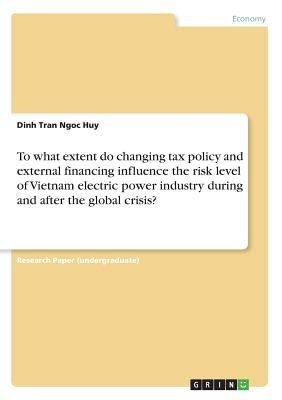
- We will send in 10–14 business days.
- Author: Dinh Tran Ngoc Huy
- Publisher: GRIN Verlag
- Year: 2018
- Pages: 24
- ISBN-10: 3668622124
- ISBN-13: 9783668622128
- Format: 14.8 x 21 x 0.2 cm, minkšti viršeliai
- Language: English
- SAVE -10% with code: EXTRA
To what extent do changing tax policy and external financing influence the risk level of Vietnam electric power industry during and after the global crisis? (e-book) (used book) | bookbook.eu
Reviews
Description
Research Paper (undergraduate) from the year 2015 in the subject Business economics - Industrial Management, grade: 4.0, language: English, abstract: Throughout years, electric power industry in Viet Nam has reached a lot of achievements. Under the volatility of stock price, and changes in macro factors such as inflation and interest rates, the well-established electric market in Viet Nam has many efforts to recover and grow from the crisis 2008. This study analyzes the impacts of both tax rate policy and leverage on market risk for the listed firms in the electric power industry as it becomes necessary. First, by using quantitative and analytical methods to estimate asset and equity beta of total 20 listed companies in Viet Nam electric power industry with a proper traditional model, we found out that the beta values, in general, for many companies are acceptable. Second, under 3 different scenarios of changing tax rates (20%, 25% and 28%), we recognized that there is not large disperse in equity beta values in each scenario of leverage, estimated at 0,032 for current leverage situation. Third, by changing tax rates in 3 scenarios (25%, 20% and 28%), we recognized both equity and asset beta mean values have positive relationship with the increasing level of tax rate. Finally, this paper provides some outcomes that could provide companies and government more evidence in establishing their policies in governance.
EXTRA 10 % discount with code: EXTRA
The promotion ends in 22d.12:13:43
The discount code is valid when purchasing from 10 €. Discounts do not stack.
- Author: Dinh Tran Ngoc Huy
- Publisher: GRIN Verlag
- Year: 2018
- Pages: 24
- ISBN-10: 3668622124
- ISBN-13: 9783668622128
- Format: 14.8 x 21 x 0.2 cm, minkšti viršeliai
- Language: English English
Research Paper (undergraduate) from the year 2015 in the subject Business economics - Industrial Management, grade: 4.0, language: English, abstract: Throughout years, electric power industry in Viet Nam has reached a lot of achievements. Under the volatility of stock price, and changes in macro factors such as inflation and interest rates, the well-established electric market in Viet Nam has many efforts to recover and grow from the crisis 2008. This study analyzes the impacts of both tax rate policy and leverage on market risk for the listed firms in the electric power industry as it becomes necessary. First, by using quantitative and analytical methods to estimate asset and equity beta of total 20 listed companies in Viet Nam electric power industry with a proper traditional model, we found out that the beta values, in general, for many companies are acceptable. Second, under 3 different scenarios of changing tax rates (20%, 25% and 28%), we recognized that there is not large disperse in equity beta values in each scenario of leverage, estimated at 0,032 for current leverage situation. Third, by changing tax rates in 3 scenarios (25%, 20% and 28%), we recognized both equity and asset beta mean values have positive relationship with the increasing level of tax rate. Finally, this paper provides some outcomes that could provide companies and government more evidence in establishing their policies in governance.


Reviews